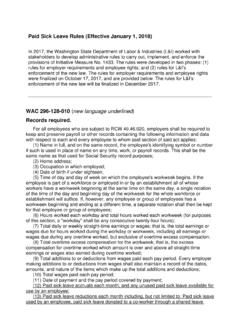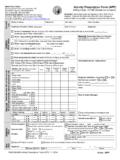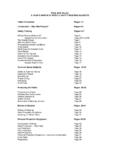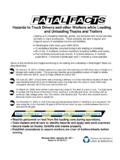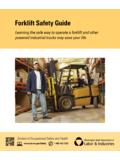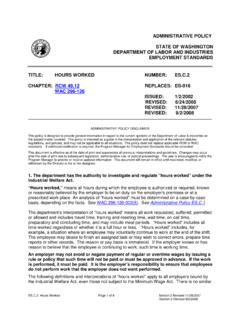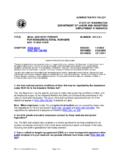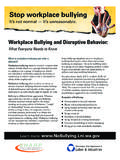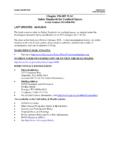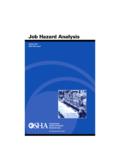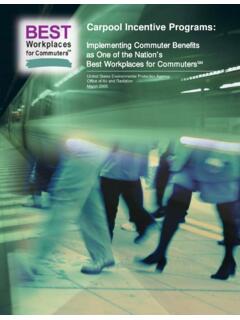Transcription of Employer’s Return-to-Work Guide
1 Employer s Return-to-Work GuideFinancial incentives available from L&IIII ContentsEmployer s Return-to-Work GuideWorkplace Safety, the Best InsuranceThe best way to manage workers compensation costs is to prevent injuries. An effective accident prevention program will help you identify hazards in your company that could lead to injuries and prevent them from and health professionals, industrial hygienists, ergonomists and risk management specialists from the Department of Labor & Industries (L&I), Division of Occupational Safety and Health, provide free consultations to employers. Learn more at .In addition, L&I offers a number of online services to help employers improve workplace safety. Learn more at . 1 Return to work: Good for your business, your employees, your bottom line ..12 Know the options: How return to work works ..33 Before and after: What you should do if your employee gets hurt ..74 How L&I can help you: Experts, services and dollars.
2 95 Know the basics of workers comp claims ..126 Tools you can use ..137 Frequently asked questions about job modifications ..161 1 Return to work: Good for your business, your employees, your bottom strikes. One of your employees is injured on the job and faces a lengthy recovery. You re concerned about your employee and you re concerned about your company not to mention the cost of your workers compensation comp claims involving time off work can drive up your rates. However, for the vast majority of claims, steps taken early can speed the employee s recovery and reduce claim booklet explains the importance of return to work in assuring the best possible recovery for your employee with the least impact on your is return to work ?Return to work simply means helping your employee get back to work as soon as possible after a job-related injury or illness. For example, he or she could work shorter hours, do different work temporarily or perform light duty until fully your employee connected with the workplace is both good medicine and good business.
3 Research has shown that effective Return-to-Work strategies promote a faster recovery and prevent a downward spiral into disability. Return-to-Work options can take many forms and there are many resources to assist you benefitProviding Return-to-Work options benefits the injured employee and it reduces the financial impact on your workers compensation premiums. Simply put, employers with fewer injuries pay less. In the landscaping industry, for example, premiums range from $ per hour to $ per hour, per employee, depending on the employer s claims history and the number of hours reported in a three-year period. In restaurants and taverns, that range is 42 cents per hour to $ per hour; in concrete work, $ per hour to $ per hour. Less time off work translates into less impact on the premiums you addition to reducing claim costs and insurance premiums, an effective Return-to-Work strategy: Encourages communication between you and your injured employee a key factor in his or her recovery.
4 Allows a skilled and experienced employee to continue working for you. Keeps loss of productivity to a minimum. Reduces the costs of training new employees. Creates an opportunity to complete work usually left undone. May reduce the risk of Your Claim-Free Discount!Employers qualify for a claim-free discount after three years without a compensable claim (a claim involving time-loss or a permanent disability award).The discount saves employers between 10 and 40 percent from the base insurance rate for their risk class, depending on the company s single compensable claim will eliminate the claim-free discount. Losing the discount may be more costly than preventing time-loss (through Return-to-Work options) or keeping the injured employee on your more information, contact your account manager in the Employer Services section of L&I; your employees benefitReturn-to-work options help preserve long-term earning power: Keeps the employee active and speeds medical recovery.
5 Shifts focus from dis-ability to ability. May reduce the risk of re-injury. Provides a sense of job security. Allows the employee to maintain contact with co-workers. Shows you value your employee and his/her contributions to your to work: Good for your business, your employees, your bottom for a successful RTW strategyA successful Return-to-Work strategy begins with commitment from the business owner and/or top management. Commitment means: Believe in the benefits of return to work for your company and your employees. Develop a written procedure for returning injured workers to the workplace. This information should be part of your new employee orientation, so all employees know what to do if an injury occurs. Designate a Return-to-Work lead. Ideally, this person would accompany an injured worker to the initial doctor s visit and support him/her through the Return-to-Work process. The RTW lead should have the responsibility and the authority to facilitate return to management specialists from L&I can help you set up a Return-to-Work process and answer your questions.
6 (See Page 11 for contact information.) 1 Why is Return to Work Important?One Company s Experience Many factors determine premium costs including number of employees, types of jobs performed and the number and costs of claims. One especially important factor is how long an employee is unable to work due to his or her injury. A small grocery store with 11 employees discovered this. In 2009, the store had a workers compensation claim that involved extensive time off work. That claim caused the company s experience factor to increase from in 2011 to in 2012, and increased annual premiums by $3, this store operates on a 2 percent profit margin, the store would need to generate an additional $158,400 in sales annually, just to break even on the increase. Because the claim impacts rates for three years, the total sales needed to offset the increase could exceed $475, business s situation is different, but this store s experience illustrates that the decision to find accommodations and develop effective Return-to-Work strategies makes good economic 2 Know the options: How return to work return to work means you keep a valuable employee and limit the financial impact of his/her claim on your insurance premiums.
7 Employers and employees who remain in close communication and work together are best able to limit time off the u the employer can be the catalyst for achieving return to work as quickly as possible. The process you and your employee use may be very informal, or you may choose a more documented process, depending on the situation. The informal processThe process can be informal when return to work is progressing smoothly. If you and your employee are functioning as partners in the process, there is less need to create a paper trail or involve Labor & Industries. You may want to use this informal process when: Good communication exists between you and your employee. There is agreement between you and your employee about his/her ability to perform a different job. Your employee is motivated to return to work, or to keep working, after an How It Works (at right) for an example of how an informal process can lead to a successful return to for success with an informal process1.
8 Talk to your employee and determine if physical restrictions will keep him/her from performing regular Depending on the answers to 1, modify your employee s job to meet those restrictions. 3. Consider placing your employee in an alternative job during recovery, if you cannot modify the regular Talk with your employee s health-care provider if you and/or your employee have any significant questions or issues regarding IT WORKS:A Return-to-Work SUCCESS STORYAn electrical contractor with a dedicated safety program arranged for an injured employee to do a light-duty job that involved compiling and updating information on locks and tags. The employee used the Internet and called local contacts to gather information and identify new technology. The company incorporated what he learned into its lockout/tagout program. 4 How much documentationdo you need?In some cases, you will want to document your attempts to return your employee to work. For example, you may want to be certain the light-duty work sufficiently accommodates physical restrictions or you are not clear what those restrictions are.
9 Documentation is useful if your injured employee is not cooperating with your efforts to return him or her to work. If these situations occur, you may choose to do one or more of the following: Ask the attending health-care provider to specify work restrictions in writing. Provide a written description of the work duties to the attending provider for comment. (See Page 14.) Send a letter to your employee specifying the job title, supervisor, hours, location and start date for the return to work. Follow the process described in Section 3, under After an injury. Review medical and other claim information on the Claim & Account Center ( ).DisagreementsWhat should you do if you and your employee disagree about the best course of action, or confusion exists, and you and your employee are unable to resolve the problem? Contact the L&I office nearest you. We can help you and your injured employee achieve a safe and timely return to work. (See Page 9 for additional information.)
10 Return-to-Work options: transitional jobs A transitional job is a way for your employee to return to work when restrictions preclude him/her from performing the job held when the injury occurred. It allows your employee to work for you while he/she is still recovering. There are several types of transitional workModified work involves an adjustment or alteration to the way a job is normally performed in order to accommodate the employee s physical restrictions. This can be as simple as changing the lifting requirements. Job modification funds may be available from L&I to help you purchase tools, equipment or appliances that allow your employee to the options: How return to work works. 2 HOW IT WORKS:A Return-to-Work SUCCESS STORYJob ModificationAn office worker injured her neck in a car accident that occurred during work-related travel. Limited neck motion kept her from performing clerical work full time. L&I provided job modification funds to buy a high-backed chair that supported her neck.

